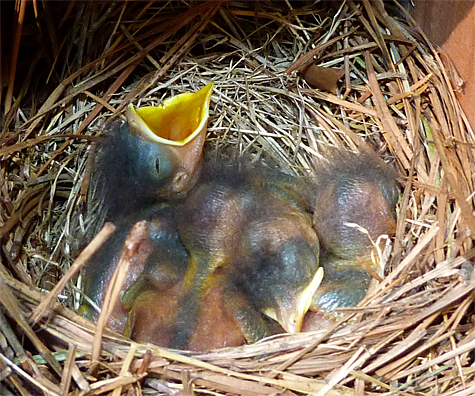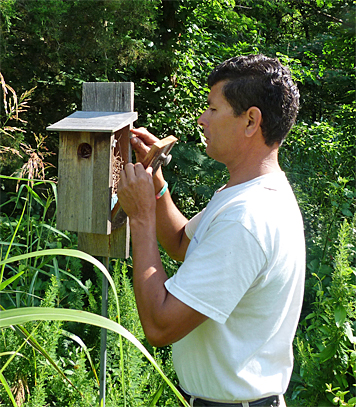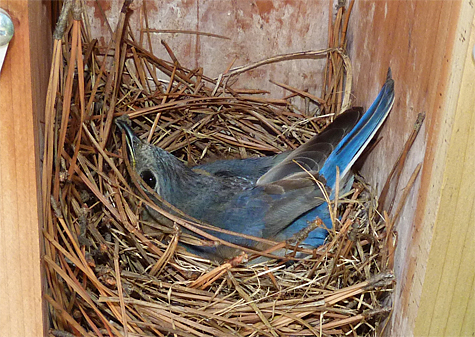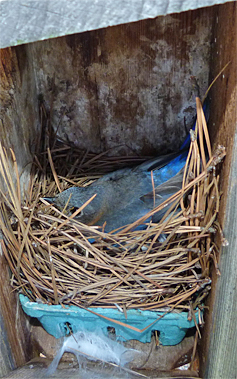
The noise and movement created by my opening the nest box stimulated at least one of the nestlings in the box at the Train Tunnel to open up and ready itself for a tasty morsel of food. Sorry little bluebird, it’s only me and not your parents that caused the fuss.
This nest seems to be doing fine, no problems with moisture and the birds all look healthy.
The nest in the flower meadow at the Take Off in Catch the Wind still has no activity after apparently loosing it occupants a few weeks ago to a rat snake (my best guess).

The flower meadow nest box will be cleaned out this week in hopes that another pair of birds will use it for nesting.
The Sail Boat Pond nest box still has no occupants. The ants have again moved out. Leaving the side of the nest box open for several days clears out the ants, but will they come back after closing the box again? We’ll see what happens next week.
Still no takers at the Amphimeadow nest box.
Last week I reported that the nest box next to the Picnic Dome had a nest inside, but no eggs. The female has been busy. She apparently laid all of her eggs since last Tuesday (5/29) and is now incubating.

I don’t know how many eggs she’s sitting on since she wouldn’t move when I opened the side of the box to peek in. I didn’t want to stress her unduly so I took a photo, quickly shut the box, and went on my way.

Also sitting on eggs is the female that resides at the Butterfly House nest box. We know how many eggs she’s incubating. Last week’s inspection of the box revealed five blue eggs.
We now have three empty nest boxes, the Take Off site, the Sail Boat Pond nest, and the Amphimeadow nest box. We have two bluebirds sitting on 5 plus eggs at the Picnic Dome and the Butterfly House (don’t know how many eggs are in the Picnic Dome nest), and there are four brand spankin’ new bluebirds in the Train Tunnel nest.
I’m going to make a guess that there are four eggs in the Picnic Dome nest. If I’m right, than we now have 9 incubating eggs and four nestlings in three active nests as this goes to press!
Till next time….
Greg, found this in Wikipedia, and it enhanced my appreciation of bluebirds and your efforts in preserving them:
“By the 1970s, bluebird numbers had declined by estimates ranging to 70% due to unsuccessful competition with house sparrows and starlings, both introduced species, for nesting cavities, coupled with a decline in habitat. However, in late 2005 Cornell University’s Laboratory of Ornithology reported bluebird sightings across the southern U.S. as part of its yearly Backyard Bird Count, a strong indication of the bluebird’s return to the region. This upsurge can largely be attributed to a movement of volunteers establishing and maintaining bluebird trails.
Of all the birds a gardener could choose to attract, the bluebird is the quintessential helpful garden bird. Gardeners go to extreme lengths to attract and keep them in the garden for their beneficial properties. Bluebirds are voracious insect consumers, quickly ridding a garden of insect pests.”
Don’t forget pesticide use. In fact, and I don’t have any hard data to back it up, but I’d bet pesticides played a bigger part in the decline than the introduced birds. Sure, around cities and towns House Sparrows and Starlings may have had a bigger impact on the bluebirds, out competing them for nest sites, but not out in the countryside.
House Sparrows, European Starlings, and let’s include the Rock Dove, or Rock Pigeon (the familiar pigeon), are much maligned by birders and naturalists. But in my opinion, they’re filling a niche in towns and cities that probably no other bird can fill, or wants to fill. And, it was people who brought the birds (sparrows, starlings and pigeons) into this country in the first place, so it’s not really the birds’ fault, they’re simply doing what they need to do to survive. But that’s another subject…
I would also check out this site for a history of bluebirds http://www.sialis.org/history.htm
The first section is more or less bluebird trivia or pop culture, but a chronological history follows.
From the URL notice http://www.sialis.org, Sialia sialis is the scientific name for Eastern Bluebird.
Thanks,